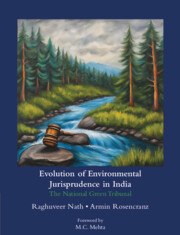Book contents
- Frontmatter
- Dedication
- Contents
- List of Images
- Foreword
- Preface
- Acknowledgements
- List of Abbreviations
- 1 Introduction to the National Green Tribunal: The Need for a “Green Court”
- 2 The National Green Tribunal Act, 2010: Analysis and Interpretation
- 3 Interpretation and Application of Environmental Principles
- 4 Evaluating the National Green Tribunal after a Decade: Challenges to Overcome
- Interview with Justice Swatanter Kumar
- Interview with Vimal Bhai
- Index of Cases
1 - Introduction to the National Green Tribunal: The Need for a “Green Court”
Published online by Cambridge University Press: 15 January 2025
- Frontmatter
- Dedication
- Contents
- List of Images
- Foreword
- Preface
- Acknowledgements
- List of Abbreviations
- 1 Introduction to the National Green Tribunal: The Need for a “Green Court”
- 2 The National Green Tribunal Act, 2010: Analysis and Interpretation
- 3 Interpretation and Application of Environmental Principles
- 4 Evaluating the National Green Tribunal after a Decade: Challenges to Overcome
- Interview with Justice Swatanter Kumar
- Interview with Vimal Bhai
- Index of Cases
Summary
1.1 INTRODUCTION TO ENVIRONMENTAL PROBLEMS AND HISTORICAL CONTEXT
If metaphors are an essential part of legal imagination, Bruno Latour's metaphor of the “fabric of law” aptly captures law's incessant endeavour to cover “everything completely and seamlessly”. Well-established doctrines, principles, and procedures provide a predetermined framework that seeks to regulate social interactions. To keep the legal fabric warm and ironed, law exudes a homeostatic quality that is manufactured by the obligation to keep the fragile tissue of rules and texts intact. As a result, a premium is put on legal stability and coherence. This premium is expressed in many ways: the significance accorded to the rule of law and legal certainty, the run of precedent in common law, the emphasis on legal formalism and reasoning, and circumscribing of the role of courts.
However, environmental law is the law relating to environmental problems. The nature of environmental problems, thus, has a significant influence throughout the creation and operation of environmental law. It moulds the latter's structure and asks questions that tend to stretch the legal imagination of courts and lawyers. Being polycentric, normatively complex, interdisciplinary, socio-politically charged, and scientifically uncertain, environmental problems produce legal heat that tends to expand the contours of the legal fabric. Hence, understanding the nature of environmental problems is crucial to understanding and evaluating the role courts have played in adjudicating such problems.
Environmental problems come in many shapes and sizes, and each is embedded in its own political and cultural context. Despite this diversity, however, environmental problems seem to have a common structure. This structure is highlighted in a short story that Elizabeth Fisher narrates in relation to car parking in East Oxford. When she moved to East Oxford in the early 1990s, there was plenty of parking space on the streets. However, by the early 2000s, due to a rapid increase in the number of cars parking, there was a lack of free parking spaces. Due to this, ambulances, fire engines, and pedestrians found it increasingly difficult to access the roads in East Oxford. Moreover, taxis refused to drop residents at their homes, often complaining that it would be too difficult to manoeuvre around the badly parked cars. The local authority finally took notice and proposed a permit system whereby two permits would be issued per house. This, however, resulted in a mixed public reaction.
- Type
- Chapter
- Information
- Evolution of Environmental Jurisprudence in IndiaThe National Green Tribunal, pp. 1 - 30Publisher: Cambridge University PressPrint publication year: 2025

